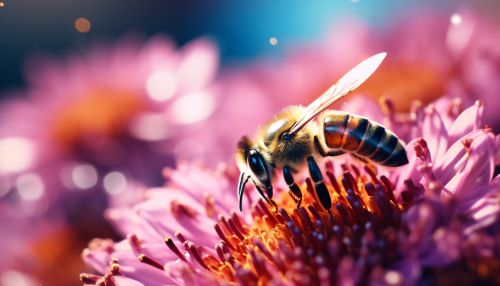Pollinator
Introduction
Pollinators are a diverse group of animals that assist in the transfer of pollen from the male reproductive structures (anthers) to the female reproductive structures (stigmas) of flowering plants. This process, known as pollination, is crucial for the reproduction of many plant species and plays a significant role in the biodiversity of ecosystems worldwide.
Types of Pollinators
There are several types of pollinators, including insects, birds, and mammals. The most well-known pollinators are bees, but other insects such as butterflies, moths, beetles, and flies also play a significant role. Birds, particularly hummingbirds, and some species of bats are also important pollinators. In addition, some small mammals, such as certain rodents and marsupials, can also act as pollinators.
Insects


Insects are the most common type of pollinator. Bees, including honey bees and bumblebees, are the most well-known and are especially important for pollinating agricultural crops. Other insects, such as butterflies and moths, are also significant pollinators. They typically pollinate plants with deep flowers, as their long proboscises allow them to reach the nectar at the base of the flower.
Birds
Birds, particularly hummingbirds, are important pollinators in certain ecosystems. They typically pollinate brightly colored, tube-shaped flowers that can accommodate their long beaks. In the process of feeding on nectar, they transfer pollen from flower to flower.
Mammals
Certain mammals, such as bats and some rodents, also act as pollinators. Bats are particularly important in tropical and desert ecosystems, where they pollinate a variety of plants, including many species of cacti and agave. Some small mammals, such as certain rodents and marsupials, also act as pollinators, although their role is less well understood.
Pollinator Behavior
Pollinators visit flowers in search of food, mates, shelter and nest-building materials. The primary food sources are nectar and pollen. Nectar is a sweet liquid produced by plants specifically to attract pollinators. Pollen, which is needed for plant reproduction, also provides a source of protein and fats.
Pollinators have developed a variety of behaviors and physical characteristics that enhance their ability to pollinate certain types of flowers. For example, bees are able to see ultraviolet light, which allows them to detect patterns on flowers that are invisible to the human eye. These patterns, known as nectar guides, direct the bee to the source of nectar and pollen.
Importance of Pollinators
Pollinators play a crucial role in the reproduction of many plant species. Without pollinators, these plants would not be able to produce fruits and seeds, which are important food sources for other wildlife. Pollinators are therefore essential for maintaining biodiversity in many ecosystems.
In addition to their ecological importance, pollinators are also economically important. Many agricultural crops depend on pollinators, and without them, crop yields would decrease significantly. It is estimated that pollinators contribute billions of dollars to the global economy each year.
Threats to Pollinators
Pollinators face a variety of threats, including habitat loss, pesticide exposure, disease, and climate change. Habitat loss due to urban development, agriculture, and logging can reduce the availability of food and nesting sites for pollinators. Pesticides can kill pollinators or impair their ability to navigate and reproduce. Diseases, parasites, and invasive species can also have negative impacts on pollinator populations.
Climate change poses additional challenges for pollinators. Changes in temperature and precipitation patterns can affect the timing of flower blooming and the availability of nectar and pollen. This can disrupt the synchrony between plants and their pollinators, potentially leading to declines in both plant and pollinator populations.
Conservation of Pollinators
Efforts to conserve pollinators focus on protecting and restoring habitats, reducing pesticide use, and addressing the impacts of climate change. Creating pollinator-friendly gardens, parks, and farms can provide important habitat for pollinators. Reducing pesticide use, particularly in agricultural settings, can also help protect pollinator populations.
Research on pollinators and their role in ecosystems is also crucial for conservation efforts. By understanding the behaviors, needs, and threats of different pollinator species, scientists can develop more effective strategies for their conservation.
